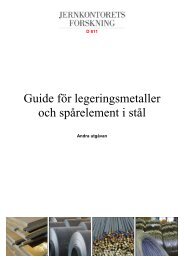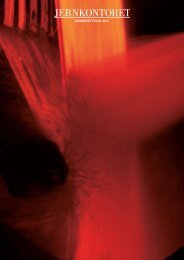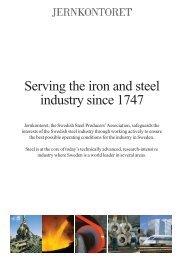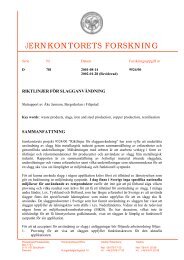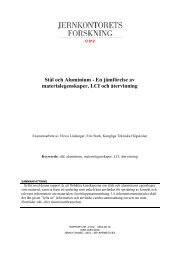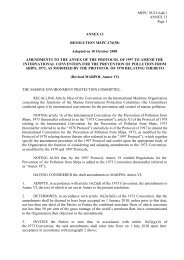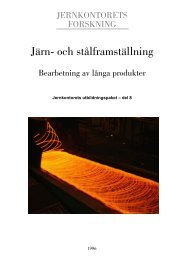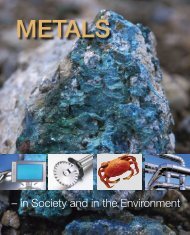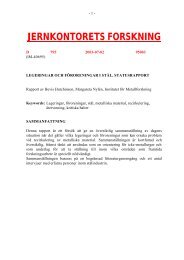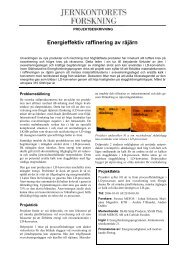Opportunities and dangers of using residual elements ... - Jernkontoret
Opportunities and dangers of using residual elements ... - Jernkontoret
Opportunities and dangers of using residual elements ... - Jernkontoret
Create successful ePaper yourself
Turn your PDF publications into a flip-book with our unique Google optimized e-Paper software.
5.2.3 End-propertiesTensile properties, strengthIn reference [6], which reviews the influence <strong>of</strong> <strong>residual</strong> <strong>elements</strong> on mechanical properties<strong>of</strong> low-carbon steels, it is observed that all <strong>residual</strong> <strong>elements</strong> increase strength <strong>and</strong> decreaseductility <strong>and</strong> drawing properties. These effects are more pronounced for low carbon cleansteels (low-carbon, extra low carbon <strong>and</strong> ULC-IF steel grades) than for medium <strong>and</strong> highcarbon steel grades.For cold rolled <strong>and</strong> annealed sheet, the major part <strong>of</strong> the product mix is low carbon or ULCsteel. These steel grades are very sensitive to the content <strong>of</strong> <strong>residual</strong> <strong>elements</strong>. Sn, Cu, Ni<strong>and</strong> Cr increases the tensile strength <strong>of</strong> ULC-Ti steel grades <strong>and</strong> decrease their ductility(elongation). Sn, As, Cu, Ni <strong>and</strong> Mo decrease ductility <strong>of</strong> ULC-IF <strong>and</strong> ELC.Thereafter are presented results <strong>of</strong> studies about mechanical properties on specific types <strong>of</strong>LC steels.The effects <strong>of</strong> some <strong>residual</strong> <strong>elements</strong> on the properties <strong>of</strong> low carbon steel sheetscontaining titanium are reported in reference [45]. Copper specifically lowers theelongation <strong>of</strong> the material <strong>and</strong> increases the yield strength (Figure 24 A) while contributingto a refinement <strong>of</strong> the microstructure Tin increases the tensile strength <strong>of</strong> <strong>and</strong> lowerselongation <strong>and</strong> r-value (Figure 24 B). A refinement <strong>of</strong> the grain size was observed withincreasing tin content. The change in tensile strength was reported to be approximately 45MPa / 0.1 w% tin. Tin has a larger difference in atomic radius versus iron compared tocopper, nickel <strong>and</strong> chromium. This causes tin to have a larger effect in both solid solution<strong>and</strong> as a precipitate.The influence <strong>of</strong> nickel is at about the same magnitude as copper with respect to tensilestrength increase. Only minor influences on elongation <strong>and</strong> r-value were observed atvarying nickel content <strong>and</strong> at different heating temperatures, though the small changes islikely closer related to the low carbon content in combination with the presence <strong>of</strong>titanium. In total the influence <strong>of</strong> nickel contents up to 0.12 w% have little effects on themechanical properties <strong>of</strong> low-carbon titanium containing steel sheet.The effect <strong>of</strong> <strong>residual</strong>s on tensile properties <strong>and</strong> microstructure <strong>of</strong> low-carbon (0.04%) <strong>and</strong>medium carbon (0.2%) steel grades was studied in [46]. An increase in tensile strength <strong>and</strong>a slight decrease in ductility (combination <strong>of</strong> solid solution hardening <strong>and</strong> grainrefinement) was observed for both types <strong>of</strong> steel The high tensile strength <strong>of</strong> steelcontaining more Mn <strong>and</strong> Si is thought to be mainly associated with increased pearlitecontent. For low carbon steels, the ferrite grain-size decreases from 24 to 18,5 µm for0.04%Sn. But further addition (0.08%Sn <strong>and</strong> 0.05%P) <strong>and</strong> addition <strong>of</strong> 1.2%Mn <strong>and</strong> 0.3%Si only slightly decrease ferrite grain-size. For medium C steels (with 1.2%Mn <strong>and</strong> 0.3%Si), the ferrite grain-size decreases from 14 to 10µm for <strong>residual</strong>s increasing (0.08%Sn,0.4%Cu, 0.4%Ni).39



